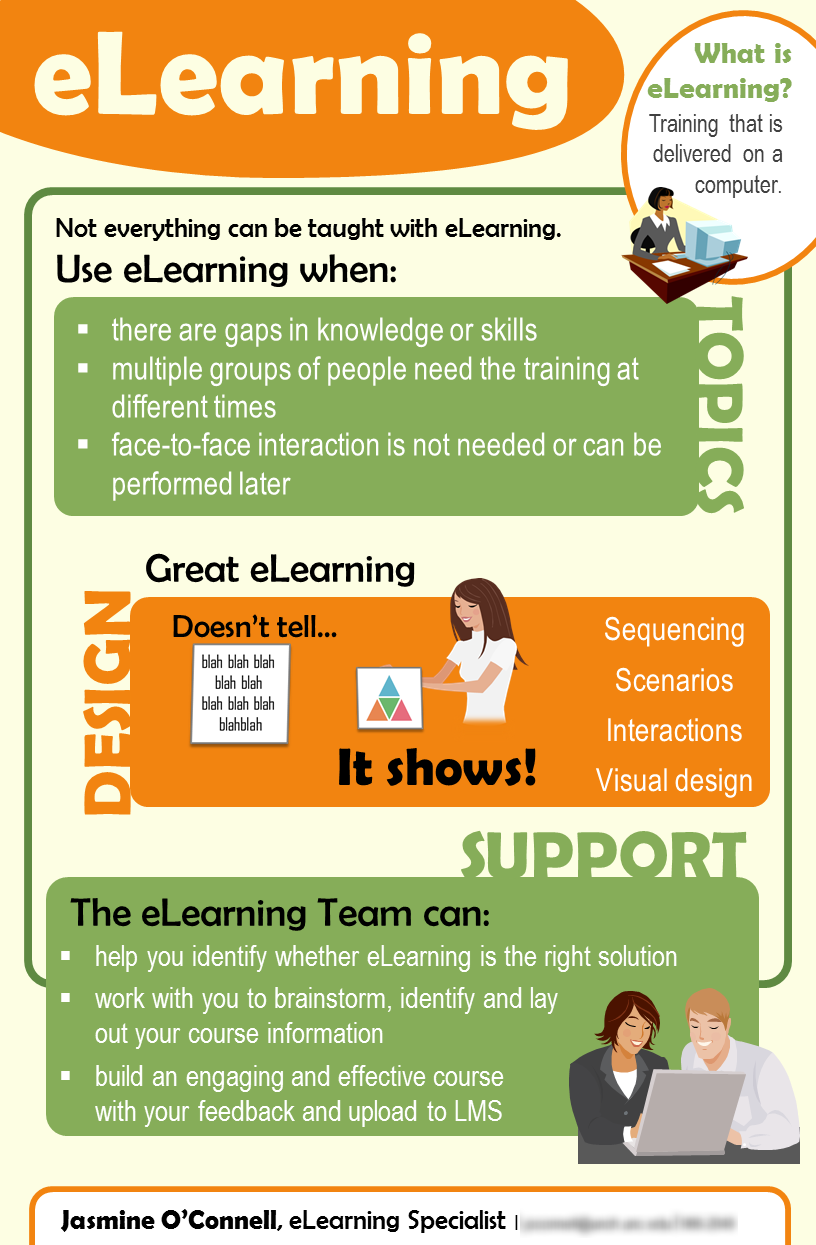Aug
2021
instructional design and elearning
https://www.eteachonline.com/blog
+++++++++++++
more on instructional design in this IMS blog
https://blog.stcloudstate.edu/ims?s=instructional+design
Digital Literacy for St. Cloud State University
https://www.eteachonline.com/blog
+++++++++++++
more on instructional design in this IMS blog
https://blog.stcloudstate.edu/ims?s=instructional+design
++++++++++++++
more on gaming in this IMS blog
https://blog.stcloudstate.edu/ims?s=gaming
https://elearningindustry.com/instructional-design-models-and-theories
1. Virtual Reality, or VR
Ultimately, the key question to consider when adopting anything new is whether it will help you achieve the desired outcome. VR shouldn’t be incorporated into learning just because it’s a common buzzword. Before you decide to give it a go, consider how it’s going to help your learner, and whether it’s truly the most effective or efficient way to meet the learning goal.
2. Gamification
considering introducing an interactive element to your learning, don’t let this deter you—just ensure that it’s relevant to the content and will aid the learning process.
3. Artificial Intelligence, or AI
If you are confident that a trend is going to yield better results for your learners, the ROI you see may well justify the upfront resources it requires.
Again, it all comes down to whether a trend is going to deliver in terms of achieving an objective.
4. Microlearning
The theory behind microlearning makes a lot of sense: organizing content into sections so that learning can fit easily with modern day attention spans and learners’ busy lifestyles is not a bad thing. The worry is that the buzzword, ‘microlearning’, has grown legs of its own, meaning the industry is losing sight of its’ founding principles.
+++++++++
more on elearning in this IMS blog
https://blog.stcloudstate.edu/ims?s=elearning
LinkedIn discussion from the group: Higher Education Teaching and Learning
https://www.linkedin.com/groups/2774663/2774663-6276441184563011585
+++++++++++++++
more on e-learning in this IMS blog
https://blog.stcloudstate.edu/ims?s=elearning
By Leila Meyer 11/28/16
According to the report, one of the main reasons for the growth in generic e-learning content and courses is the adoption of teaching and learning methods such as the flipped classroom, blended learning and virtual classrooms
The report identifies the proliferation of mobile devices on campus as the third factor helping to drive adoption of these courses. “The availability of gadgets such as e-book readers, tablets, and laptops, coupled with better and uninterrupted Internet connectivity, has led to a greater penetration of digital classrooms and e-learning products,”
++++++++++++++++
more on elearning in this IMS blog:
https://blog.stcloudstate.edu/ims?s=elearning
What Does Recent Pedagogical Research Tell Us About eLearning Good Practice?
Many instructors indicate that they want their elearning teaching approaches to be evidence-based. Indeed, there are rich and varied sources of research being conducted on elearning good practices available in scholarly journals and government reports. However, few of us have time to keep up with these publications. In this session Christina Petersen will do some of that work for you. She summarize findings from recent government and university reports which review over 1,000 online learning studies. Additionally, she will summarize the findings from newly published articles from pedagogical journals with important information about good practices in online education. These practices address evidence-based methods for promoting student engagement in online courses, good practices for video production, and other topics related to online teaching. We will discuss the importance of all of these findings for your teaching.
Christina Petersen is an Education Program Specialist in the Center for Educational Innovation at the University of Minnesota where she partners with faculty and departments to help create and redesign courses and curriculum to promote maximal student learning. She facilitates a monthly Pedagogical Innovations Journal Club at the CEI. She has a PhD in Pharmacology and her teaching experience includes undergraduate courses in Pharmacology, and graduate courses in Higher Education pedagogy. Her teaching interests include integrating active learning into science courses, teaching in active learning classrooms, and evidence-based teaching practice. She is co-author of a soon-to-be-released book from Stylus, “A Guide to Teaching in Active Learning Classrooms”
View the eLearning Summit presentation
WebEx link for the webinar
Date: Thursday, December 1, 2016
Time: 2:00 p.m., Central Daylight Time (Chicago, GMT-05:00)
Session number: 805 333 130
Session Password: MNLC@2016
Teleconference information
To receive a call back, provide your phone number when you join the training session. Alternatively, you can call one of the following numbers and enter the access code:
Call-in toll-free number: 888-742-5095
(US) Call-in number: 619-377-3319
(US) Conference Code: 297 345 8873
++++++++++++++++++
more on elearning in this IMS blog:
http://graphs.net/e-learning-infographics.html

++++++++++++++++++
more on elearning in this IMS blog
https://blog.stcloudstate.edu/ims?s=elearning

++++++++++++++++
more about gamification in learning in this blog:
https://blog.stcloudstate.edu/ims?s=gamification





http://blog.commlabindia.com/elearning-design/elearning-development-aspects-to-consider-infographic





+++++++++++++++++++++++++++++++++++
online learning
http://blog.teachable.com/the-ultimate-guide-to-launching-your-online-course

+++++++++++++++++++++++++++++++++++
more on elearning in this IMS blog:
https://blog.stcloudstate.edu/ims?s=elearning
Dr. Vijayender Nalla Rafiat A. I am visiting back to your post to share the insights from engaging students in an e-learning mode. You can review the post here:
https://www.linkedin.com/pulse/live-learning-ice-breaker-engaging-e-learners-dr-vijayender-nalla
While there has been significant attention to improving the key technology (that is the Learning Management Systems) the critical instructional design part (which forms the essence of creating the engagement) is in it’s early stages. Instructional design, the way we at Agribusiness Academy understand is made up of 2-elements: 1) quality of content (the storytelling style is what seems to work which should form the core focus area for the content expert to master); and 2) the manner in which this content is delivered (to the learner) to fulfill the learning objectives .
Live Learning initiative